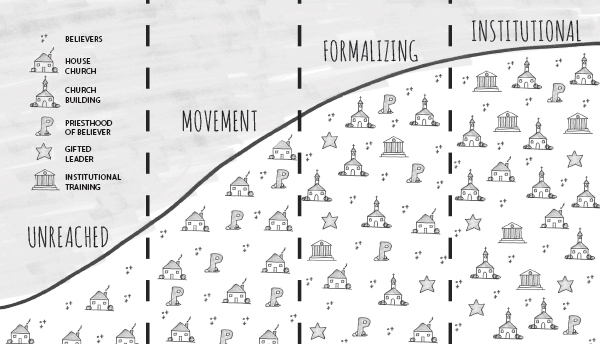
Here is a brief and helpful article from Steve Smith at Mission Frontiers: 4 Stages of a Movement. For me, it quickly helps explain some of the major tensions/issues that arise when a Kingdom movement breaks out in an unreached people group (UPG) who are near-culture to a institutional church. Well meaning institutional church leaders often use their own paradigms of training for equipping emerging leaders in the movement phase (stage 2) which may actually threaten the movement.
Unfortunately, these same emerging leaders often quickly try to mimic an institutional church which is inappropriate and unsustainable at that time. Similarly, new believers in UPGs who have been taken out of their contexts for short-term training often feel they need to aim for the institutional church far too soon.
In all honesty, “we have to ask whether it is fair to expect a movement to survive only as a movement. Either the movement disintegrates or it becomes an institution, this is simply a sociological law. Every religious group that started out as a movement and managed to survive, did so because it was gradually institutionalized” (Bosch 1991, 52). Yet I believe this truism is partially why we need to continually reimagine afresh what the church looks like in each generation of every people and place. For instance, as is our reality today, the sheer numbers of Muslim refugees who are coming to faith in many places where an institutional church exists should compel the church to rethink her very nature as the body of Christ. (There are other issues (or cans of worms) like the “homogeneous unit principle” to discuss as well – but more on that later.)
Here are some highlights the the article:
Throughout history, most movements have gone through four phases or stages (and sometimes back again through grass-roots movements) [unreached – movement – formalizing – institutional]. Failure to understand these can create unreal expectations that are inappropriate for a given stage of a movement…
[Stage 3 – Formalizing] The result is that normal disciples can be intimidated from doing the work of the ministry. They do not have the abilities or specialized training/credentials of the professional leaders. Therefore, the concept of the priesthood of the believer (in terms of “every member a minister”) wanes. A smaller percentage of disciples continues in ministering to others. No one intends for this to occur, and many pastors will do their best in stages three and four to build up their church members as ministers and leaders, but the “clergy/laity” divide becomes more profound…
[Stage Four – Institutional] The upshot is that the concept of priesthood of the believer wanes drastically. Believers bring their lost friends to church rather then lead them to faith themselves…
[Stage Four Workers in Stage One] The early church does not appear to have entered this final stage until the Fourth Century A.D. Most movements progress through these stages. The difficulty comes when we lack this historical perspective and try to make sense of movements at earlier stages. What happens when a missionary leaves a stage four church and tries to do evangelism and church planting in stage one? Inadvertently he tries to plant stage four disciples and churches because that is all he knows…
[Stage Two Workers in Stage Four] What happens with believers from stage one or two who visit leaders and churches in stage four? A not-uncommon consequence is death of the movement phase and immediately entering the formalizing and institutional phase.
[Stage Four Leaders Watching a Stage Two Movement] When our whole frame of reference is stage four, it is easy to criticize what we see in stage two. We can easily label the house churches as “not real churches.” Or, we can require that leaders meet certain credentialing requirements before they can perform the ordinances. Or, as we feel compassion for pastors that are bi-vocational, we may dedicate money to fund them full-time, thereby creating a benchmark that is no longer reproducible. In all, we can kill a movement when we implement extra-biblical requirements that are a yoke too heavy into these early stages…
The challenge is to keep a movement at the movement stage as long as possible and to not let the formalizing impede the progress of the kingdom. But when it does begin to slow down, going back to simple biblical processes and methods of earlier stages can spark a new movement.
Read the whole thing.
An accessible and accurate translation of the Quran that offers a rigorous analysis of its theological, metaphysical, historical, and geographical teachings and backgrounds, and includes extensive study notes, special introductions by experts in the field, and is edited by a top modern Islamic scholar, respected in both the West and the Islamic world.


